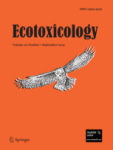A comparison of the short-term toxicity of cadmium to indigenous and alien gammarid species.
A comparison of the short-term toxicity of cadmium to indigenous and alien gammarid species
 Alien invasive species (AIS) are, next to global change, considered to be one of the major threats to global biodiversity. Globalisation and habitat deterioration positively contribute to the establishment success of AIS. Besides appropriate vectors of introduction and favourable environmental conditions their success can be attributed to species specific traits such as a high reproduction rate, an omnivorous diet and the ability to easily cope with changing environmental conditions. In this study, we hypothesized that AIS are more tolerant to metal pollution compared to native species. We tested this hypothesis based on a comparison between native and alien freshwater shrimps that were exposed to different concentrations of cadmium. We found significant differences in sensitivity to metal pollution between different species which should be taken into consideration in environmental risk assessment and water quality standard setting. There was no clear trend in Cd sensitivity between native and alien shrimps, indicating that alien species do not have an advantage over native ones in cadmium contaminated waters.
Alien invasive species (AIS) are, next to global change, considered to be one of the major threats to global biodiversity. Globalisation and habitat deterioration positively contribute to the establishment success of AIS. Besides appropriate vectors of introduction and favourable environmental conditions their success can be attributed to species specific traits such as a high reproduction rate, an omnivorous diet and the ability to easily cope with changing environmental conditions. In this study, we hypothesized that AIS are more tolerant to metal pollution compared to native species. We tested this hypothesis based on a comparison between native and alien freshwater shrimps that were exposed to different concentrations of cadmium. We found significant differences in sensitivity to metal pollution between different species which should be taken into consideration in environmental risk assessment and water quality standard setting. There was no clear trend in Cd sensitivity between native and alien shrimps, indicating that alien species do not have an advantage over native ones in cadmium contaminated waters.
Scientific abstract
Amphipods play an important role in many aquatic ecosystems and are commonly used in ecotoxicology and ecosystem health assessment. Several alien gammarids have been introduced in many regions of the world during the last decades. In this study, we investigated if differences in cadmium sensitivity occurred between (1) different species belonging to the family Gammaridae and (2) different populations of the same species originating from a polluted or a non-polluted site. The acute cadmium toxicity to two native (Gammarus pulex and Gammarus fossarum) and four alien (Dikerogammarus villosus, Echinogammarus berilloni, Gammarus roeseli and Gammarus tigrinus) gammarids occurring in Belgium was tested. Significant differences (P < 0.05) in median lethal concentrations (LC50) were found between the different species, with 72h-LC50s ranging from 6.3 µg/l to 268 µg/l and 96h-LC50s from 4.7 µg/l to 88.9 µg/l. No clear trend in Cd sensitivity was found when comparing native and alien gammarids. D. villosus, an alien invasive species, was the most sensitive to Cd toxicity and E. berilloni, another alien species, the least sensitive. In addition, larger Gammarid species were more sensitive to Cd toxicity than smaller ones. No significant differences were found between populations of the same species originating from metal polluted sites or non-polluted sites. Overall, our results showed that considerable differences in Cd sensitivity exist between gammarid species, which should be taken into consideration in environmental risk assessment and water quality standard setting. Finally, our data suggest that alien gammarids would not have an advantage over native gammarids in Cd contaminated environments.
Full reference (link)
Boets P., Lock K., Goethals P.L.M., Janssen C.R., De Schamphelaere K.A.C. (2012). A comparison of the short-term toxicity of cadmium to indigenous and alien gammarid species. Ecotoxicology 21(4): 1135-1144.
